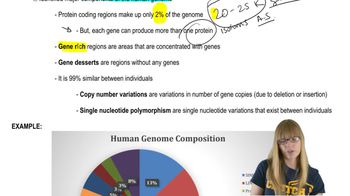Bacterial Pseudomonas species often possess plasmids encoding genes involved in the catabolism of organic compounds. You have discovered a strain that can metabolize crude oil and wish to identify the gene(s) responsible. Outline an experimental protocol to find the gene or genes required for crude oil metabolism.
Table of contents
- 1. Introduction to Genetics51m
- 2. Mendel's Laws of Inheritance3h 37m
- 3. Extensions to Mendelian Inheritance2h 41m
- 4. Genetic Mapping and Linkage2h 28m
- 5. Genetics of Bacteria and Viruses1h 21m
- 6. Chromosomal Variation1h 48m
- 7. DNA and Chromosome Structure56m
- 8. DNA Replication1h 10m
- 9. Mitosis and Meiosis1h 34m
- 10. Transcription1h 0m
- 11. Translation58m
- 12. Gene Regulation in Prokaryotes1h 19m
- 13. Gene Regulation in Eukaryotes44m
- 14. Genetic Control of Development44m
- 15. Genomes and Genomics1h 50m
- 16. Transposable Elements47m
- 17. Mutation, Repair, and Recombination1h 6m
- 18. Molecular Genetic Tools19m
- 19. Cancer Genetics29m
- 20. Quantitative Genetics1h 26m
- 21. Population Genetics50m
- 22. Evolutionary Genetics29m
18. Molecular Genetic Tools
Genetic Cloning
Problem 28
Textbook Question
The CRISPR-Cas system has great potential but also raises many ethical issues about its potential applications because, theoretically, it can be used to edit any gene in the genome. What do you think are some of the concerns about the use of CRISPR-Cas on humans? Should CRISPR-Cas applications be limited for use on only certain human genes but not others? Explain your answers.
 Verified step by step guidance
Verified step by step guidance1
Step 1: Understand the CRISPR-Cas system as a powerful gene-editing tool that allows precise modifications to DNA sequences within the genome, which can potentially correct genetic disorders or alter traits.
Step 2: Identify ethical concerns related to CRISPR-Cas use in humans, such as unintended off-target effects, long-term health consequences, potential for creating genetic inequalities, and the moral implications of altering human germline cells that can be inherited by future generations.
Step 3: Consider the debate about limiting CRISPR-Cas applications to certain genes, focusing on the distinction between therapeutic uses (e.g., correcting disease-causing mutations) versus enhancement purposes (e.g., altering physical traits or intelligence), which raises questions about fairness, consent, and societal impact.
Step 4: Reflect on the importance of regulatory frameworks and ethical guidelines to ensure responsible use of CRISPR-Cas technology, balancing scientific advancement with respect for human rights and safety.
Step 5: Formulate your position by weighing the potential benefits of CRISPR-Cas in treating genetic diseases against the risks and ethical dilemmas, and explain whether you believe restrictions should be placed on which human genes can be edited and why.
 Verified video answer for a similar problem:
Verified video answer for a similar problem:This video solution was recommended by our tutors as helpful for the problem above
Video duration:
2mPlay a video:
Was this helpful?
Key Concepts
Here are the essential concepts you must grasp in order to answer the question correctly.
CRISPR-Cas System and Gene Editing
CRISPR-Cas is a powerful gene-editing technology that allows precise modification of DNA sequences within organisms. It uses a guide RNA to target specific genes and the Cas enzyme to cut DNA, enabling gene insertion, deletion, or alteration. This technology has vast potential in medicine, agriculture, and research.
Recommended video:
Guided course

Regulation
Ethical Concerns in Human Gene Editing
Ethical issues arise from the potential misuse of CRISPR-Cas, such as unintended genetic changes, germline editing affecting future generations, and social inequalities. Concerns include consent, safety, and the possibility of creating 'designer babies' or exacerbating discrimination based on genetic traits.
Recommended video:
Guided course

Human Genome Composition
Regulation and Limitations of Gene Editing
Regulating CRISPR-Cas involves setting boundaries on which genes can be edited to balance benefits and risks. Limitations may focus on therapeutic uses for serious diseases while restricting enhancements or non-medical modifications, ensuring responsible use and addressing societal and ethical implications.
Recommended video:
Guided course

Regulation
Related Videos
Related Practice
Textbook Question
501
views


